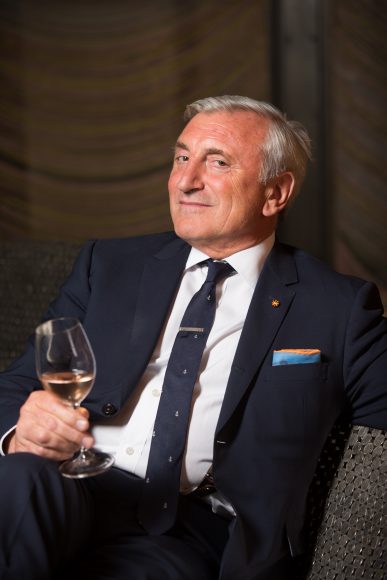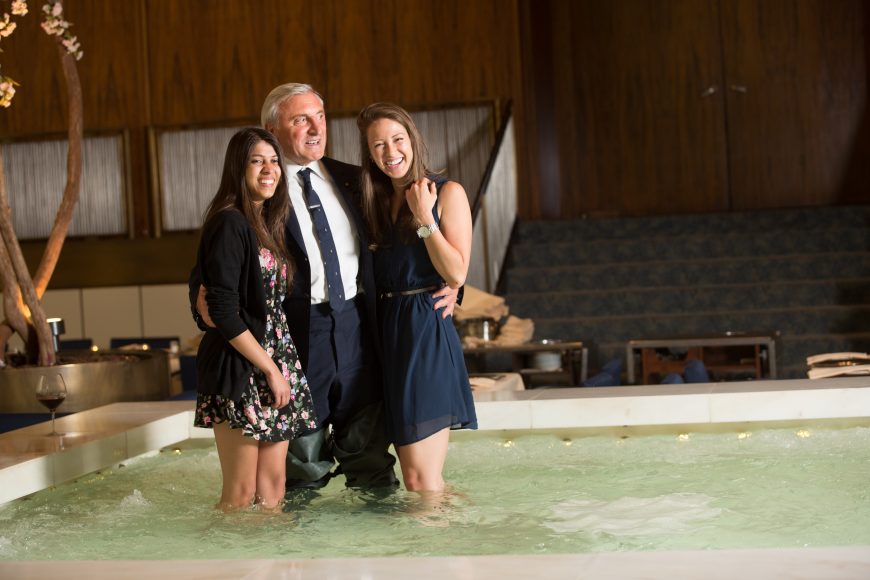Julian Niccolini, the ebullient managing partner of The Four Seasons restaurant in midtown Manhattan, sets out three tastings of Armagnac, a rich amber-colored cousin of Cognac from Gascony in southwest France. One glass contains 25-year-old Armagnac; the second, 18-year-old; and the third, 15-year-old.
You sip the 25-year-old Armagnac first. Wow. It’s a good thing you’ve just had a superb lunch of savory asparagus soup with black morels, meaty crab croquettes that melted in your mouth and – a Four Seasons signature – luxurious vanilla bean soufflé.
Because that 25-year-old Armagnac packs a wallop.
The Armagnac, Niccolini says, “is a very romantic drink, a beverage for relaxing after dinner, very European.”
And how shrewd he is to bring it to the table as an introduction to The Four Seasons, which is, after all, on the first floor of the 38-story bronze and amber glass Seagram Building and so took its inspiration in part from liquor.
Originally intended to be a restaurant for the employees of the Canadian-based Seagram’s – once the largest distiller of alcoholic beverages in the world – The Four Seasons was ultimately designed “to show off the connection between food and wine.”
“These people had the idea that food and wine go together,” Niccolini says. “And they were smart enough to know that if you drink, then you need to eat food as well.”
Indeed, long before “wine and dine,” “farm to table,” “seasonal cooking,” “locally sourced,” “healthy eating” and all the other catchphrases that are so popular now in the food industry, there was The Four Seasons, which opened in 1959 at a cost of $4.5 million ($36.7 million today), one of the largest sums ever spent on a restaurant.
“It took Alice Waters until 1972 to become the queen of seasonal cooking,” Niccolini reminds you. “Farm to table? Soon it will be cow to table.”
He is like that – straightforward but with great charm – which is a good way to describe the food at The Four Seasons. First off, the restaurant used the Japanese idea of the ephemeral world to introduce the concept of seasonal cuisine in America. Hence the name, the constantly changing menus and the ever-shifting views in the sedately sumptuous Pool Room, with its preserved cherry blossom trees standing like sentinels at the corners of the central, burbling pool in spring and palm trees taking over the duty in summer before giving way to Japanese maples in fall and bare birches in winter. Niccolini scoffs at places that say they serve fresh tomatoes out of season. Now that the soft seasons are here, this Bedford resident is at Daisy Hill Farm in neighboring Mount Kisco buying 200 to 300 pounds at a clip for the restaurant.
You won’t find farm-raised salmon on the menu. And fish from California in the wake of the Fukushima Daiichi Nuclear Power Plant meltdown that contaminated Pacific waters? Forget about it.
“One of the many reasons people have come here for more than 40 years and don’t put on any weight is that we use a limited amount of butter, and we don’t use heavy cream,” adds Niccolini, a trim, sharply handsome man who eats at the restaurant twice a day. “We use olive oil that is made only from olives with no fillers, unlike other olive oils.”
No doubt that’s why after a meal there you feel full and satisfied rather than heavy.
“The best thing is ‘Do not cheat,’” he says. “What we’re trying to do is cook food that is good for our clients.”
The Four Seasons (no relation to the hotel chain) is, of course, about a lot more than good eating. It’s about seeing and being seen – the essence of Modernism – in a landmark Modernist space. The rectangular glass building, perhaps the quintessence of the postwar International Style, was designed for Seagram’s owner Samuel Bronfman by Mies van der Rohe; the restaurant by the architect’s protégé, Philip Johnson, whose many credits include Purchase College’s Neuberger Museum of Art and his own glass home, now a New Canaan tourist attraction. Overseeing every aspect was Phyllis Lambert, Bronfman’s brilliant, uncompromising daughter.
Among the restaurant’s artistic treasures is Pablo Picasso’s 19-by-20-foot painting “Le Tricorne,” originally a backdrop for the 1920 Paris production of Leonide Massine’s ballet “The Three-Cornered Hat.” Believed to be the largest non-sculptural Picasso in the world, “Le Tricorne” depicts a colorful bullfight scene, which just about describes the controversy that erupted recently over plans to remove it. The fight pitted the RFR Holding Corp., which owns the building and says it needs to shore up the limestone wall behind it, against The New York Landmarks Conservancy, which owns the painting and says it could deteriorate if moved. This being New York, arts watchers have speculated that Aby Rosen, RFR co-founder, chair of the state Council on the Arts and a contemporary art collector, is really seeking to displace the Picasso for works by Damien Hirst and Jeff Koons.
Now all is happily resolved. The parties have agreed to send the Picasso to the New-York Historical Society, where it will go on display after being conserved.
Presently, the Picasso remains at The Four Seasons in a corridor called Picasso Alley the connects the masculine, French walnut-paneled Grill Room, where the captains of industry held sway “Mad Men”-style, giving rise to the term “power lunch”; and the lighter, airier Pool Room, the color of coffee-infused whipped cream, with chain curtains filtering the light. Traditionally, the Grill Room – still “the most powerful room in America today,” Niccolini says – is the place for lunch and the Pool Room the place for dinner. But we’re having lunch in the Pool Room and so are a lot of other people who barely notice when Secretary of the Navy Ray Mabus walks in, preceded by bodyguards, and is seated poolside. (These are for the most part New Yorkers, after all, with many patrons being from Bedford and Pound Ridge, Niccolini adds. They’re not inclined to pop up like meerkats just to get a peek at the rich and famous. If they were, their heads would be bobbing all day to get a gander at the likes of everyone from Henry Kissinger, still a Four Seasons regular with an office nearby, to Johnny Depp.)
Whether you’re Johnny Depp or John Doe, you’ll find The Four Seasons’ service to be attentive, unobtrusive and thoroughly agreeable, as demonstrated by our captain, J. Stephen MacArthur.
“One of the most important things is charm, that plays a big part,” Niccolini says, “caring for the customers.”
He describes Alex von Bidder – the restaurant’s other managing partner and co-author with John Mariani of “The Four Seasons: A History of America’s Premier Restaurant” (Smithmark Publishers) – as “the main ingredient.” As for himself, Niccolini says, “I’m in the people business.”
It is a trade he learned – along with foraging – at his parents’ “illegal restaurant” outside Lucca, the Etruscan city on the river Serchio in Tuscany. His mother would cook for everyone while his father – a poet who led Tuscany’s Resistance movement against the Fascists – would get everyone drinking. It was, more than one person has said, like something out of a Fellini movie.
After hotel school in Rome, Niccolini worked in Monte Carlo, then decided to brush up on his English in New York, where a cousin was general manager of the St. Regis hotel. It was in Manhattan in the 1970s that he caught the eye of Paul Kovi, who with Tom Margittai had taken over ownership of The Four Seasons from Restaurant Associates. Kovi suggested that young Niccolini get experience in a French restaurant. Niccolini got a job at the now-defunct Palace restaurant – then the most expensive in the city – and moonlighted as assistant maitre d’ at La Maisonette, the St. Regis’ nightclub, where admirers of Mabel Mercer’s cabaret act included Ol’ Blue Eyes.
“When Frank Sinatra showed up, he’d give out $100 tips,” Niccolini remembers.
His next encounter with Kovi led to a job managing the Grill Room in 1977, building it into a powerhouse, and, as he says, “I’m still here.”
When he’s not “here” putting in 12-hour days, Niccolini is at home in Bedford with wife Lisa, Labradoodles Dutch and Betsy and rescue cats Bee and Lucky or checking out the local food scene. He likes the Saugatuck Craft Butchery in Westport, whose brisket, he says, makes the best hamburgers, as well as 42 The Restaurant atop The Ritz-Carlton, Westchester in White Plains and chef-owner Anthony Goncalves.
Back at The Four Seasons, the times and menu may change but one thing never will and that is the restaurant’s philosophy of cooking and service.
“Honesty,” Niccolini says, “is the most important thing where food is concerned.”
For more or reservations, visit fourseasonsrestaurant.com.







